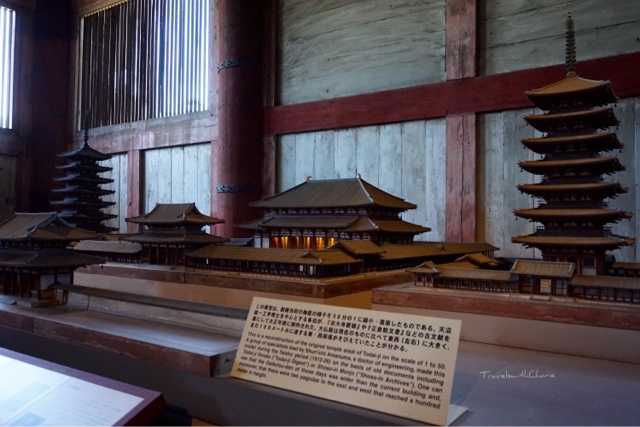As I sleep
Facing the city,
My Buddhas
Stand even in my dreams
On an autumn night.
Facing the city,
My Buddhas
Stand even in my dreams
On an autumn night.
Aizu Yaichi, Poet, historian, calligrapher 1891-1956
 |
| Daibutsu |
Nara is chock-full of historical temples, shrines and ruins, a legacy from its early influence as the capital of Japan in the 8th century. Todai-ji is the most visited of these temples. It is the home of the seated Daibutsu (Great Buddha), one of the largest bronze statues in Japan. It measures an impressive 15 meters in height and and fills the Great Hall (Daibutsuden) with its presence.
Two Bosatsu (Bodhisattva) sit on either side of Buddha.
One of several interesting displays in the Daibutsuden is the model of Todai-ji as it was in the 8th century.
It is a pleasant stroll to Todai-ji through Nara Park where deer roam freely and approach visitors with expectant eyes. They are used to being fed with shika senbei (deer crackers) which can be bought at food stalls nearby. The deer can be aggressive when they smell food so don't eat in front of them.
The Nandaimon Gate (Great South Gate) marks the entrance to temple grounds. This wooden gate dates to the 12th century and features intricate wooden brackets which support the two-tiered roof. Within the gate is a pair of fierce looking Nio guardians.
 |
| Todai-ji Temple |
The Daibutsuden is the biggest wooden building in the world under one roof though it is much smaller than the original structure which was razed by fire in 1180 during the Genpei Civil War.
 |
| Model of Todai-ji |
 |
| Nio Deity in the Daibutsuden |
The Nio deities are the traditional guardians of Buddha. They protect the temple from evil spirits and demons.
 |
| Oh deer! |
 |
| Nandaimon Gate |
The best way to get to Nara from Osaka Namba Station is to take the Kintetsu train because the Kintetsu Nara Station is closest to Nara Park and Todai-ji. The fare is 560 yen each way and the trip takes approximately 40 minutes. There’s also a convenient shopping mall at the station with restaurants, a grocery store and souvenir shops.
To learn more about Osaka, follow this link: https://www.travelswithcharie.com/2017/08/osaka-city-of-kuidaore.html
Stay connected:
*****
Images by TravelswithCharie

